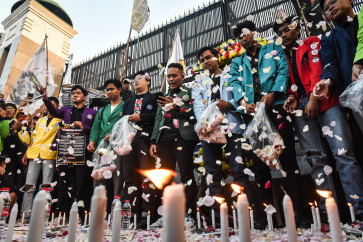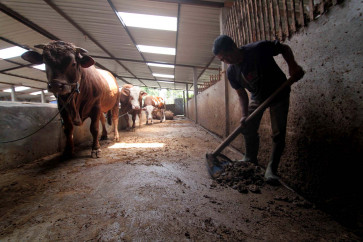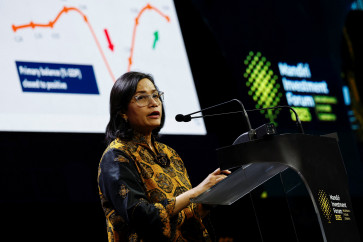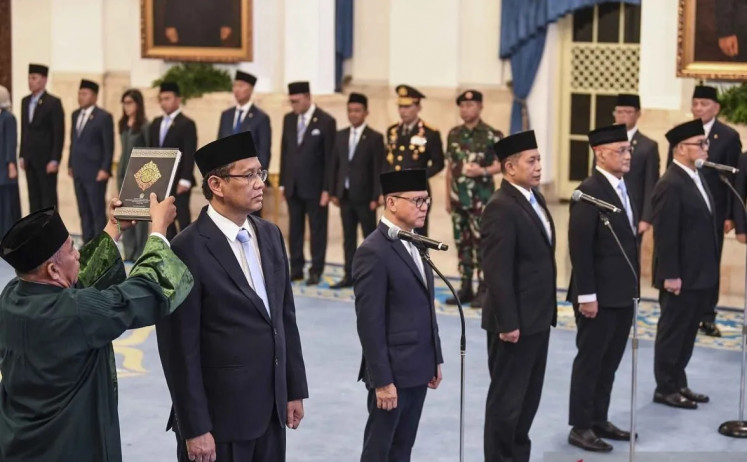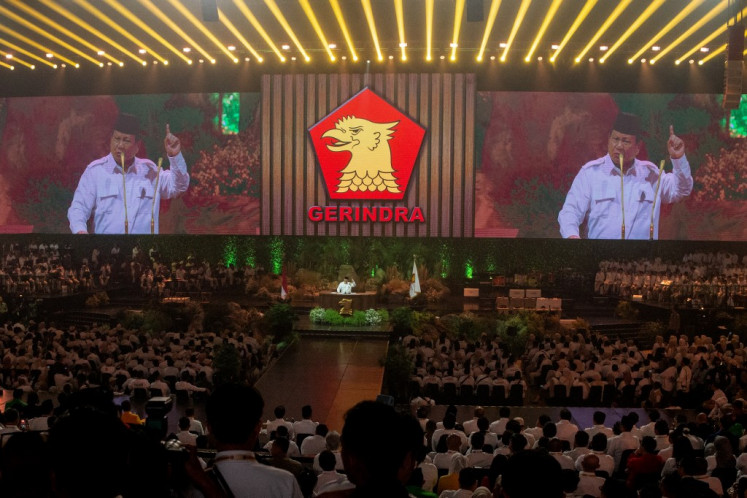Popular Reads
Top Results
Can't find what you're looking for?
View all search resultsPopular Reads
Top Results
Can't find what you're looking for?
View all search resultsA symbol of Madura’s royal glory
Ancient: The Asta Tinggi Cemetery in Kebonagung village in Sumenep, Madura, dates back to the 16th century
Change text size
Gift Premium Articles
to Anyone
A
span class="caption">Ancient: The Asta Tinggi Cemetery in Kebonagung village in Sumenep, Madura, dates back to the 16th century.: Ancient: The Asta Tinggi Cemetery in Kebonagung village in Sumenep, Madura, dates back to the 16th century.Madura, an island off the northeastern coast of Java, is famous for its karapan sapi (bull race) and carok (duel with scythes), two local traditions steeped in strong passion.
But the Madurese also have Asta Tinggi, a cemetery for their kings and nobility with an artistic blend of Islamic, European and Chinese cultures.
In Indonesia, the cemeteries of leaders of former times are closely connected with supernatural powers. Likewise, 16th-century Asta Tinggi in Kebonagung village in Sumenep, Madura, is inseparable from local belief in the presence of ancestral spirits around the site.
“Please take off your footwear before entering the cemetery complex. Any violation of this rule might provoke some curse inflicted by the ghostly protectors of this graveyard. Asta Tinggi is indeed a sacred place,” cemetery guard Marsudin, 46, told The Jakarta Post.
In January 2010, continued Marsudin, a large explosion could be heard within a one-kilometer radius of the site, the sound originating from the grave of Ajeng Salmah binti Kiai RB Abdul Latif, a descendant of King Paku Nata Ningrat the 13th (1879-1901). The cause of the strange and smokeless blast at 10:30 p.m., which damaged some parts of the grave, has remained a mystery.
“Local people believe it was magic. Apart from the explosion, eerie things have frequently been noticed around this place, such as apparitions of spirits and voices from the beyond,” he revealed.
The public notion of the sacred place, according to Marsudin, makes people observe everything required of them like entering the compound barefoot. “It’s safe to leave your shoes and sandals at the gate because visitors don’t dare to do bad deeds here,” he assured.
Pilgrims to Asta Tinggi usually perform rituals to seek help from their forebears through prayers for the success of business ventures and other efforts. Khudori, 18, a high school student, for instance, made a plea in order to pass his national exams.
“By saying a prayer here, I gain a lot of composure and self-confidence to face the coming exams because paying homage to venerated figures may help bring my plea closer to Allah to be answered,” said Khudori recently.
Nurullah, another cemetery guard, said the number of students visiting the site increased by almost 20 percent with the approaching national exams. “Some of them even spend the night in one of the tombs. They usually bring along food and mats,” he said.
Abdul Kadir, 45, an employee from Probolinggo, East Java, visited Asta Tinggi to express gratitude for a promotion. “I promised to come here to clean one of the graves soon after my promotion,” he revealed.
Fanani, a pilgrim from Situbondo, East Java, said she regularly visited the cemetery as a tribute to regal ulema figures and in a manifestation of her passion for the nation’s cultural heritage. “Asta Tinggi is mostly crowded during the fasting month of Ramadan,” Fanani noted.
Asta Tinggi, covering an approximate area of 110 by 100 meters in the southwestern part of the city of Sumenep, is a religious tourist destination there. The others are Masjid Agung, the Keraton Museum and Sayyid Yusuf’s tomb in Talango district, Poteran Island, off Sumenep.
“Asta” means cemetery and “tinggi” means high, so Asta Tinggi is widely interpreted as a graveyard situated on the peak of a hill. Bendara Ahmad says in his book Lintasan Sejarah Sumenep dan Asta Tinggi Beserta Tokoh (History of Sumenep and Asta Tinggi) that the cemetery is like a keraton (palace).
Unsurprisingly, in the past, British troops were misdirected. “As they thought it was a palace of the local kingdom, they shot a cannon from their warship in Kalianget waters, Madura. But the shot missed its target and Asta Tinggi wasn’t damaged,” he said.
According to Ahmad, Asta Tinggi has Western and Eastern structures with quite different styles of architecture. Western tombs are typical of Javanese Mataram-style buildings where early monarchs were buried such as Raden Ayu Mas Ireng, Pengeran Jimat and Bendara Saud.
Eastern tombs show a blend of Arab, Chinese, European and Javanese patterns. Among those buried there are Panembahan Sumolo and Sultan Abdurrahman. “Hundreds of graves lie in the cemetery that mostly belong to royal families,” he pointed out.
Ahmad said some research indicated the influence of Chinese, Islamic and European structural designs in Asta Tinggi. Chinese patterns can be found in decorations and carvings. European styles are noticeable in the fences surrounding the cemetery compound.
“The gate in the eastern yard of Asta Tinggi has a British touch. Islamic culture is apparent in the form of graves and the calligraphy on inscriptions and gravestones,” he said, adding the foreign and Islamic cultural mix had long testified to the existence of pluralism in Madura.
— JP/Indra Harsaputra


